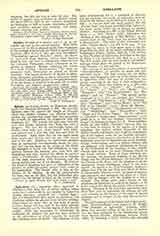

Aphraates (Gr., Aphraates; Syr., Aphrahat or Pharhad).—The long list of Syriac writers whose works have come down to us is headed by Aphraates (fourth century), surnamed the “Persian Sage”. The few biographical data which we possess of this illustrious author are gleaned from his own writings. From these we learn that he was born of pagan parents during the last half of the third century, Very probably on the frontier region of the Persian empire. After his conversion to Christianity he embraced the religious life, and was later elevated to the episcopate, on which occasion he assumed the Christian name of Jacob. The adoption of this name subsequently led to a confusion of identity, and for centuries the works of Aphraates were ascribed to the famous Jacob, Bishop of Nisibis (d. A.D. 338). It was not until the tenth century that the “Persian Sage” was finally identified with Aphraates, the name under which he is known to modern scholars. According to a MS. of the British Museum dated A.D. 1364 (Orient, 1017) Aphraates was “Bishop of the monastery of Mar Mattai”, on the eastern shore of the Tigris, near the modern Mosul in Mesopotamia. The ruins of this monastery, now called “Sheikh Matta”, are still to be seen. It was here that he seems to have spent most of his life. Regarding the date of his death, nothing is known. Barhebraeus (Chron. Eccles., Part II, -§ 10) informs us that Pharhad, or Aphraates, flourished in the time of Papas I, the Catholicus who died in A.D. 334. This is in accord with the data found in our author’s writings which place the period of his literary activity between A.D. 337 and 345.
The writings of Aphraates consist of twenty-three “Demonstrations”, or homilies on moral and controversial topics. The first twenty-two are alphabetical, each beginning with one of the Syriac letters in alphabetic order, and may be divided into two groups according to the time of their composition. The first ten, which were written in A.D. 337, treat of (i) “Faith“, (ii) “Charity”, (iii) “Fasting”, (iv) “Prayer“, (v) “Wars”, (vi) “Monks”, (vii) “Penitents”, (viii) “The Resurrection“, (ix) “Humility“, and (x) “Pastors”. The second group, composed in A.D. 344, are entitled, (xi) “Circumcision“, (xii) “The Passover”, (xiii) “The Sabbath“, (xiv) “Hortatory”, (xv) “Divers Meats”, (xvi) “The Call of the Gentiles“, (xvii) “Jesus the Messias“, (xviii) “Virginity“, () six) “The Dispersion of Israel”, (xx) “Almsgiving”, (xxi) “Persecution“, (xxii) “Death and the Latter Times”. To this collection is subjoined a twenty-third “Demonstration”, composed in A.D. 345 and entitled “Concerning the Grape”, in reference to Isaias, lxv, 8. These homilies, which are also called “Epistles” because they are in the form of answers to the queries of a friend, constitute the earliest extant document of the Syrian Church, and besides their linguistic importance are of the highest value for the Catholic apologist. They abound with precious information on the most important questions of dogmatic and moral theology, liturgy, ecclesiastical, and even profane history, and are pregnant with important conclusions in favor of the conformity of the doctrines of the Catholic Church with those of the early Christian Church in the fourth century. Some of these doctrines are, for example, the perpetual virginity of the Blessed Virgin and her Divine Maternity, the foundation of the Church on St. Peter, and the existence of all the sacraments except matrimony, which is not mentioned. In regard to the Holy Eucharist, Aphraates affirms that it is the real Body and Blood of Christ. In the seventh “Demonstration” he treats of penance and penitents, and represents the priest as a physician who is charged with the healing of a man’s wounds. The sinner must make known to the physician his infirmities in order to he healed, i.e. he must confess his sins to the priest, who is bound to secrecy. Because of the numerous quotations from Holy Writ used by Aphraates, his writings are also very valuable for the history of the canon of Sacred Scripture and of exegesis in the early Mesopotamian Church.
The editio princeps of the Syriac text of the twenty-three “Demonstrations” was issued by W. Wright, “The Homilies of Aphraates” (London, 1869). Since then another edition of the series of twenty-two has been published by the Benedictine scholar Dom Parisot [Graffin, Patrologia Syriaca (Paris, 1894), I], including a Latin version, and preceded by a learned and copious introduction. A German translation of the whole work was published by Bert [Gebhardt and Harnack, Texte and Untersuchungen (Leipzig, 1888), III]. An English translation of eight “Demonstrations”, including an historical introduction, was published by Dr. John Gwynn [Nicene and Post-Nicene Fathers (New York, 1898), XIII].
F. X. E. ALBERT

